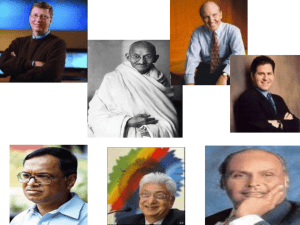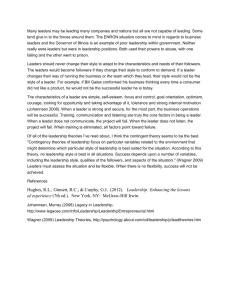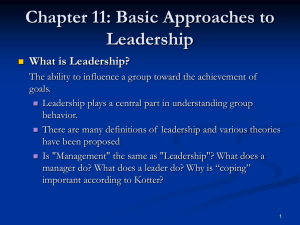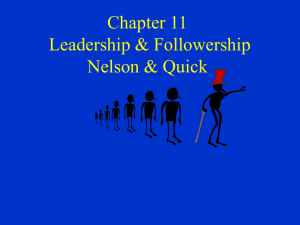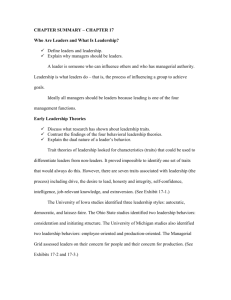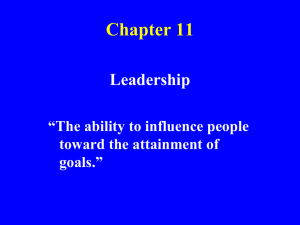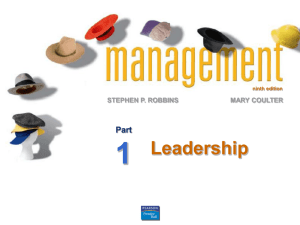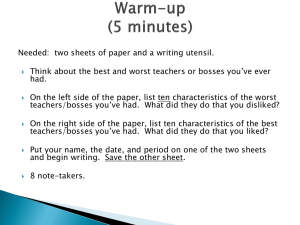Chapters 12 and 13
advertisement
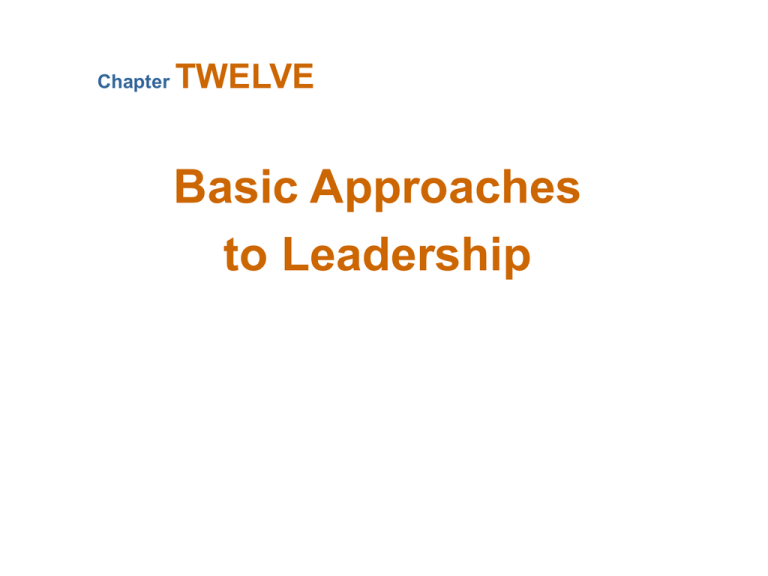
Chapter TWELVE Basic Approaches to Leadership What Is Leadership? Leadership The ability to influence a group toward the achievement of goals Management Use of authority inherent in designated formal rank to obtain compliance from organizational members Trait Theories Traits Theories of Leadership Theories that consider personality, social, physical, or intellectual traits to differentiate leaders from nonleaders Leadership Traits • Extraversion • Conscientiousness • Openness • Emotional Intelligence Trait Theories Limitations • No universal traits found that predict leadership in all situations • Unclear evidence of the cause and effect of relationship of leadership and traits • Better predictor of the appearance of leadership than distinguishing effective and ineffective leaders Behavioral Theories Behavioral Theories of Leadership Theories proposing that specific behaviors differentiate leaders from nonleaders Behavioral Theory Leadership behaviors can be taught. vs. Trait Theory Leaders are born, not made. The Managerial Grid (Blake and Mouton) Contingency Theories All of these consider the situation: – – – – Fiedler Contingency Model Cognitive Resource Theory Hersey and Blanchard’s Situational Leadership Model Path Goal Theory Key assumptions underlying the different models: – Fiedler: Leader’s style is fixed. – Other’s: Leader’s style can and should be changed. Fiedler Model Leader: Style Is Fixed (Task-oriented vs. Relationshiporiented) Key Assumption – Leader must fit situation; options to accomplish this: – Select leader to fit situation – Change situation to fit leader Cognitive Resource Theory Cognitive Resource Theory A theory of leadership that states that the level of stress in a situation is what impacts whether a leader’s intelligence or experience will be more effective. Research Support • Less intelligent individuals perform better in leadership roles under high stress than do more intelligent individuals. • Less experienced people perform better in leadership roles under low stress than do more experienced people. Contingency Approach: Hersey and Blanchard Situational Model Considers Leader Behaviors (Task and Relationship) – Assumes leaders can change their behaviors Considers Followers as the Situation – Follower task maturity (ability and experience) – Follower psychological maturity (willingness to take responsibility) Assumptions – Leaders can and should change their style to fit their followers’ degree of readiness (willingness and ability) – Therefore, it is possible to train leaders to better fit their style to their followers. Hersey and Blanchard’s Situational Leadership Theory Situational Leadership Theory (SLT) A contingency theory that focuses on followers’ readiness; the more “ready” the followers (the more willing and able) the less the need for leader support and supervision. LOW Amount of Follower Readiness Amount of Leader Support & HIGH Supervision Required HIGH LOW Leadership Styles and Follower Readiness (Hersey and Blanchard) Follower Readiness Able Unwilling Willing Supportive Participative Monitoring Leadership Styles Unable Directive High Task and Relationship Orientations Leader-Member Exchange Theory Leader-Member Exchange (LMX) Theory • Leaders select certain followers to be “in-group” members (favorites) based on competence and/or compatibility and similarity to leader • “Exchanges” with these “in” followers will be higher quality than with those who are “out” • Result: “In” subordinates will have higher performance ratings, less turnover, and greater job satisfaction. Path-Goal Theory Premise • Leader must help followers attain goals and reduce roadblocks to success • Leaders must change behaviors to fit the situation Leader-Participation Model Premise • Rule-based decision tree to guide leaders about when and when not to include subordinate participation in decision making • Considers 12 contingency variables to consider whether or not to include subordinates in decision making Chapter THIRTEEN Contemporary Issues in Leadership Framing: Using Words to Shape Meaning and Inspire Others Framing A way to use language to manage meaning Leaders use framing (selectively including or excluding facts) to influence how others see and interpret reality. Inspirational Approaches to Leadership Charismatic Leadership Theory Followers make attributions of heroic or extraordinary leadership abilities when they observe certain behaviors. Charismatic leaders: 1. Have a vision. 2. Are willing to take personal risks to achieve the vision. 3. Are sensitive to follower needs. 4. Exhibit behaviors that are out of the ordinary. Beyond Charismatic Leadership Level 5 Leaders – Possess a fifth dimension—a paradoxical blend of personal humility and professional will—in addition to the four basic leadership qualities of individual capability, team skills, managerial competence, and the ability to stimulate others to high performance – Channel their ego needs away from themselves and into the goal of building a great company Transactional and Transformational Leadership Transactional Leaders • Contingent Reward Leaders who guide or motivate their followers in the direction of established goals by clarifying role and task requirements • Management by Exception (active) • Management by Exception (passive) • Laissez-Faire Transformational Leaders Leaders who provide the four “I’s” (individualized consideration, inspirational motivation, idealized influence, and intellectual stimulation) • Idealized Influence • Inspirational Motivation • Intellectual Stimulation • Individual Consideration Authentic Leaders and Ethical Behavior Authentic leaders know who they are, what they believe in and value, and act on those values openly and candidly. – Followers see them as ethical. Ethical leaders use ethical means to get followers to achieve their goals, and the goals themselves are ethical. Trust: The Foundation of Leadership Trust A positive expectation that another will not—through words, actions, or decisions—act opportunistically Trust is a history-dependent process (familiarity) based on relevant but limited samples of experience (risk) Dimensions of Trust Integrity – Honesty and truthfulness Competence – An individual’s technical and interpersonal knowledge and skills Consistency – An individual’s reliability, predictability, and good judgment in handling situations Loyalty – The willingness to protect and save face for another person Openness – Reliance on the person to give you the full truth Three Types of Trust Deterrence-based Trust Trust based on fear of reprisal if the trust is violated Knowledge-based Trust Trust based on behavioral predictability that comes from a history of interaction Identification-based Trust Trust based on a mutual understanding of one another’s intentions and appreciation of the other’s wants and desires Basic Principles of Trust Mistrust drives out trust. Trust begets trust. Growth often masks mistrust. Decline or downsizing tests the highest levels of trust. Trust increases cohesion. Mistrusting groups self-destruct. Mistrust generally reduces productivity. Contemporary Leadership Roles: Providing Team Leadership Team Leadership Roles • Act as liaisons with external constituencies • Serve as troubleshooters • Managing conflict • Coaching to improve team member performance Contemporary Leadership Roles: Mentoring Mentor A senior employee who sponsors and supports a less-experienced employee (a protégé) Mentoring Activities • Present ideas clearly • Listen well • Empathize • Share experiences • Act as role model • Share contacts • Provide political guidance Contemporary Leadership Roles: Self-Leadership Self-Leadership A set of processes through which individuals control their own behavior. Creating Self-Leaders • Model self-leadership • Encourage employees to create self-set goals • Encourage the use of selfrewards • Create positive thought patterns • Create a climate of selfleadership • Encourage self-criticism Online Leadership Leadership at a Distance: Building Trust – The lack of face-to-face contact in electronic communications removes the nonverbal cues that support verbal interactions. – There is no supporting context to assist the receiver with interpretation of an electronic communication. – The structure and tone of electronic messages can strongly affect the response of receivers. – An individual’s verbal and written communications may not follow the same style. – Writing skills will likely become an extension of interpersonal skills Challenges to the Leadership Construct Attribution Theory of Leadership The idea that leadership is merely an attribution that people make about other individuals Qualities Attributed to Leaders • Leaders are intelligent, outgoing, have strong verbal skills, are aggressive, understanding, and industrious. • Effective leaders are perceived as consistent and unwavering in their decisions. • Effective leaders project the appearance of being a leader. Finding and Creating Effective Leaders Selection – Review specific requirements for the job – Use tests that identify personal traits associated with leadership, measure self-monitoring, and assess emotional intelligence – Conduct personal interviews to determine candidate’s fit with the job Training – Recognize that all people are not equally trainable – Teach skills that are necessary for employees to become effective leaders – Provide behavioral training to increase the development potential of nascent charismatic employees

